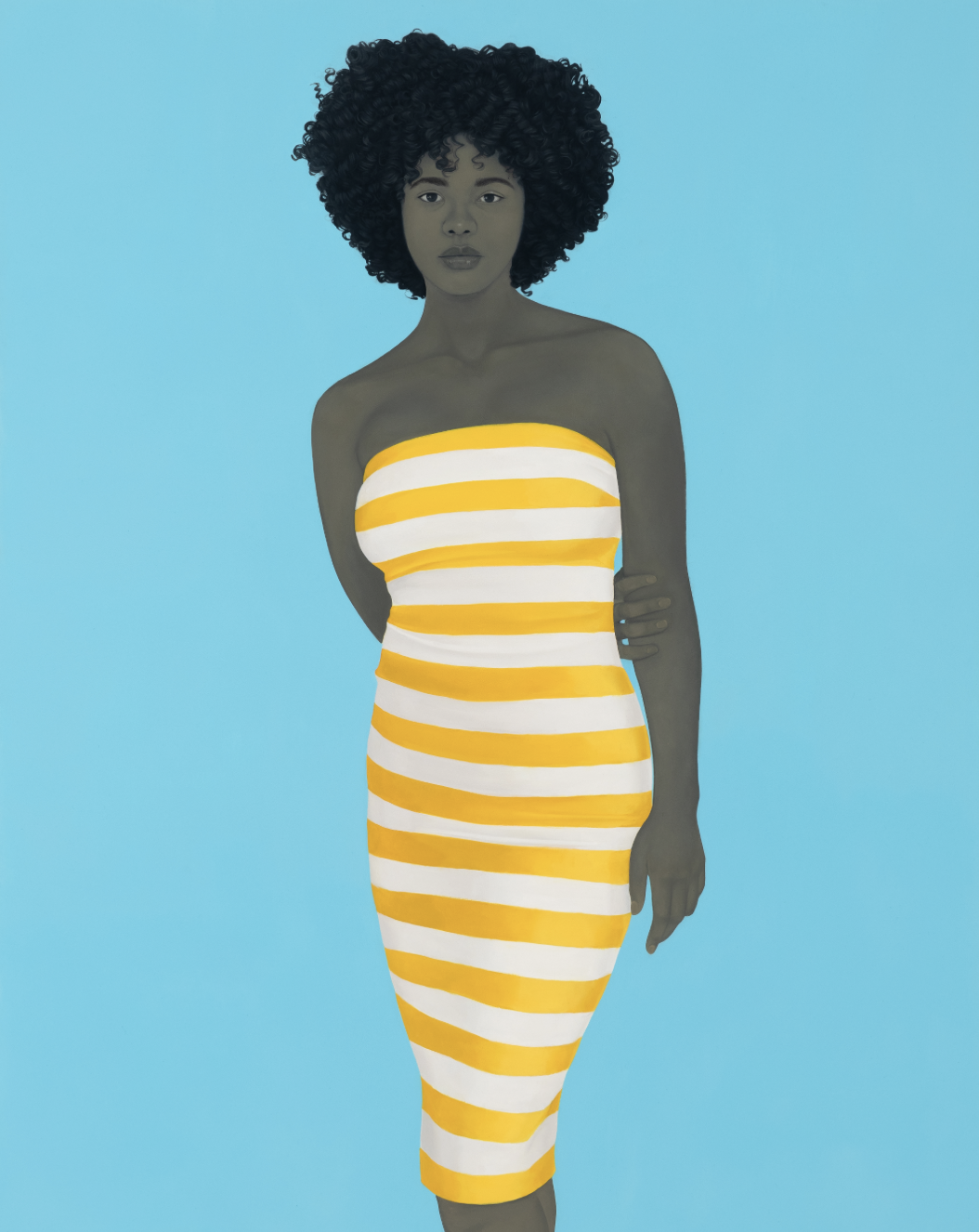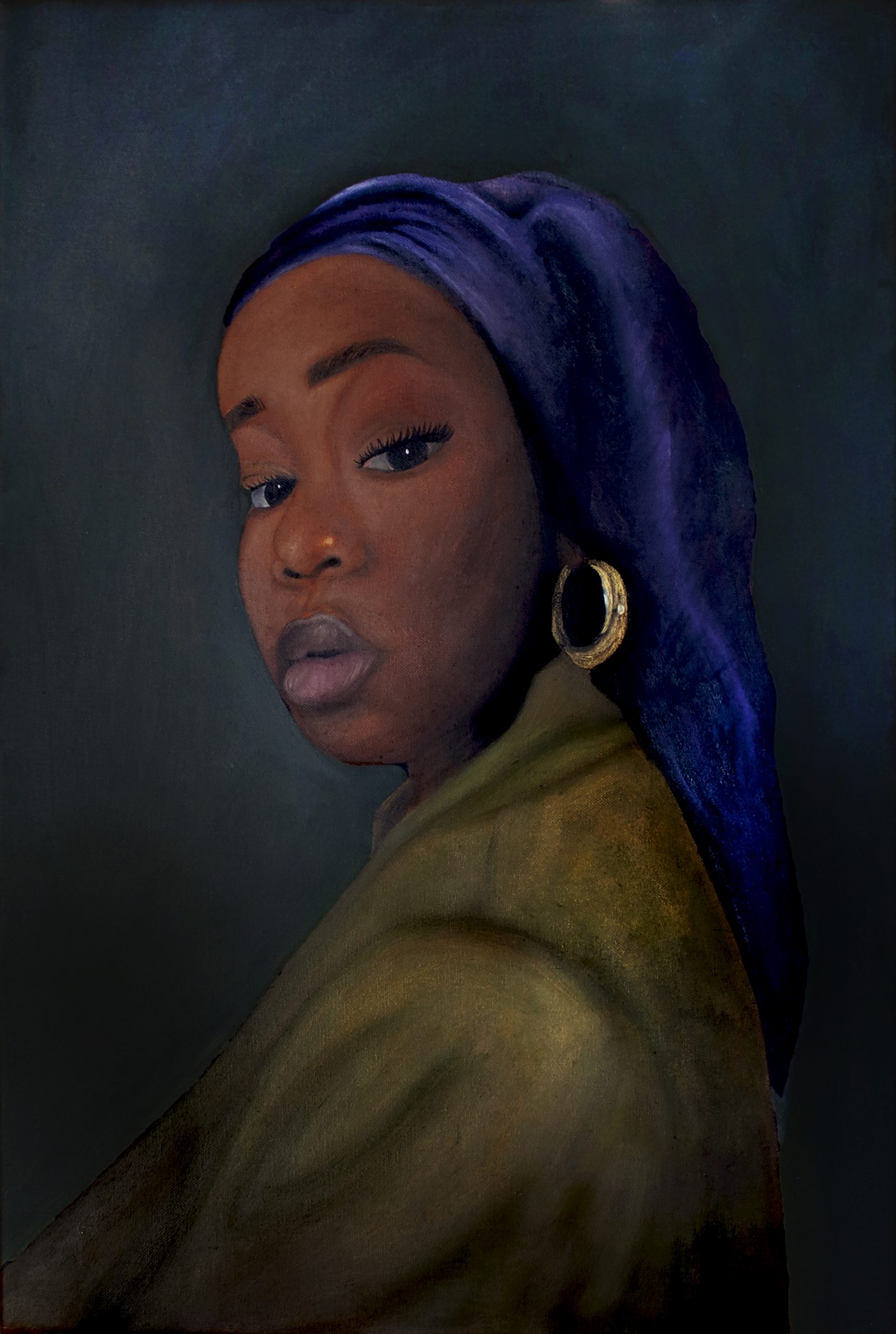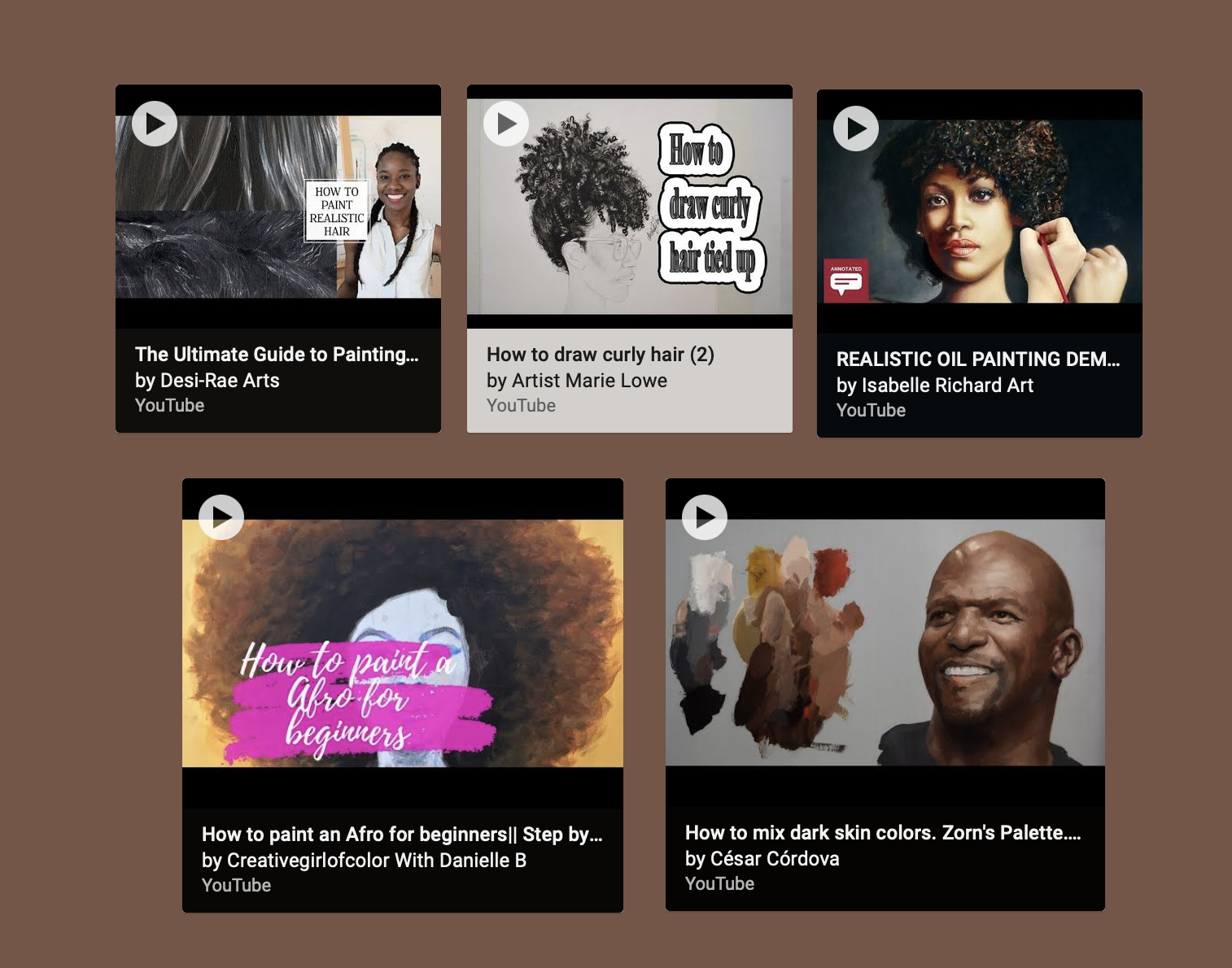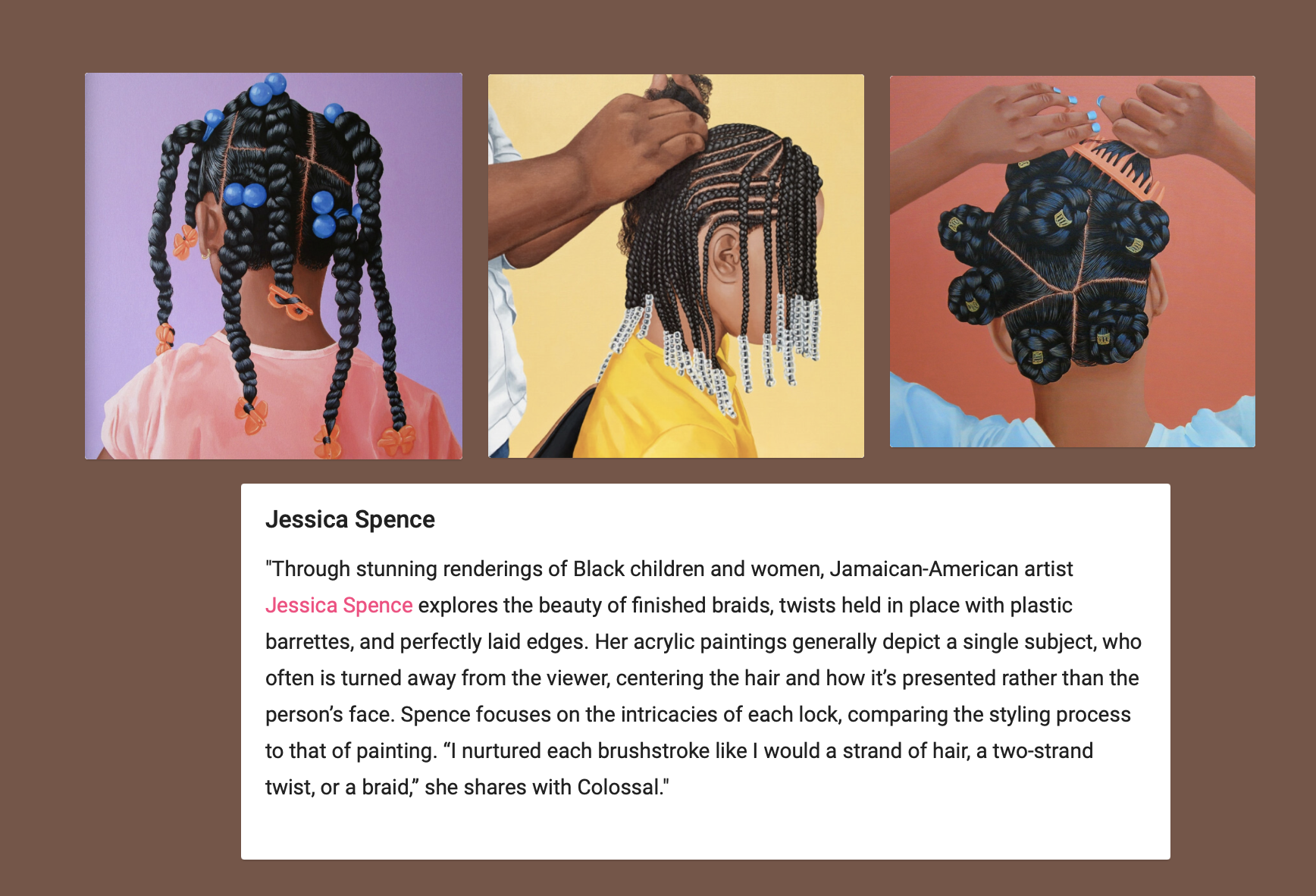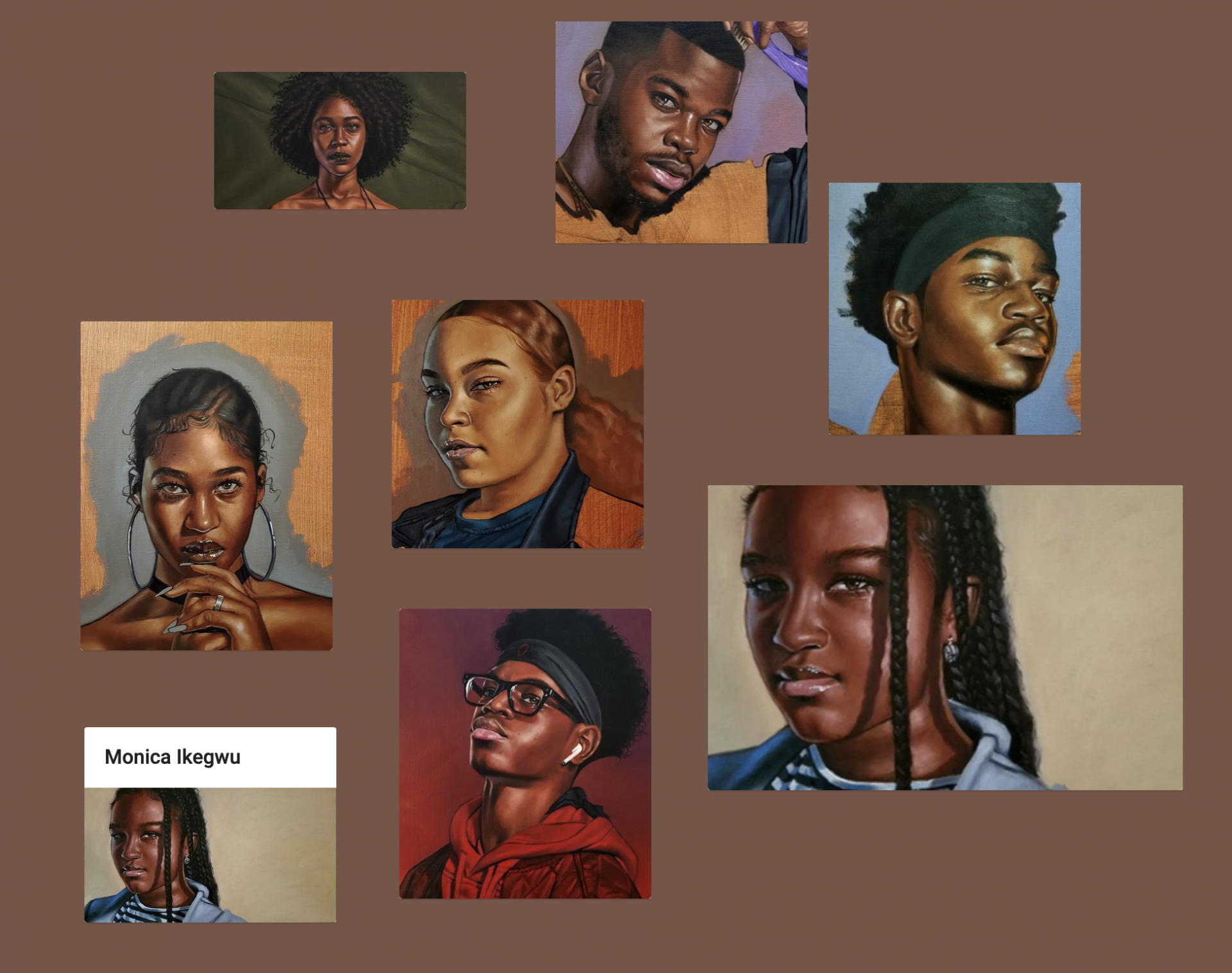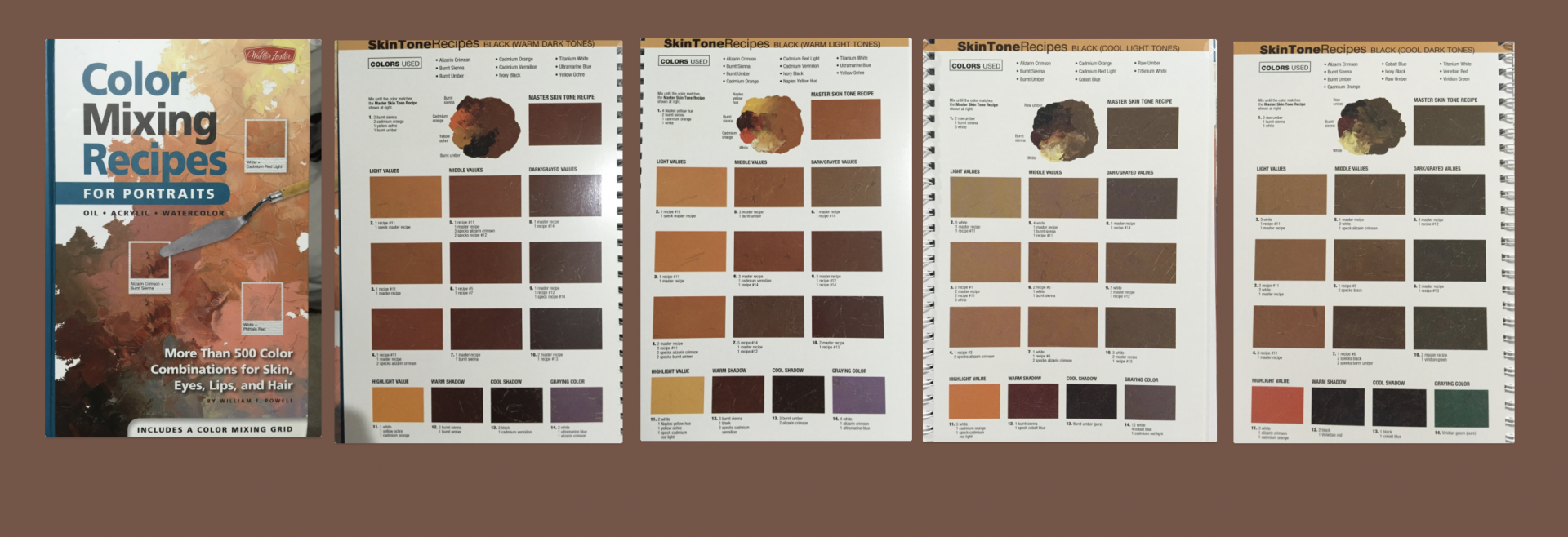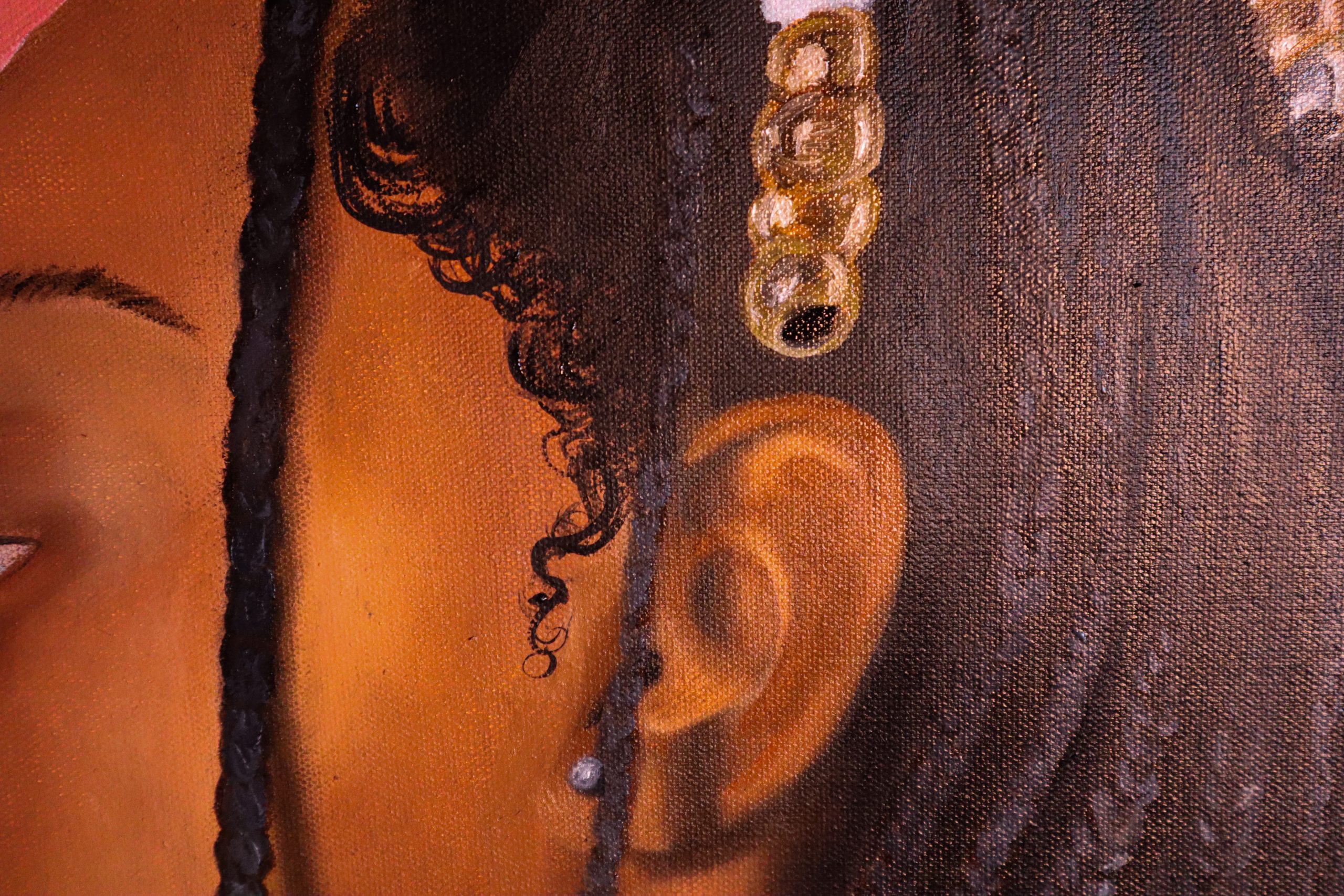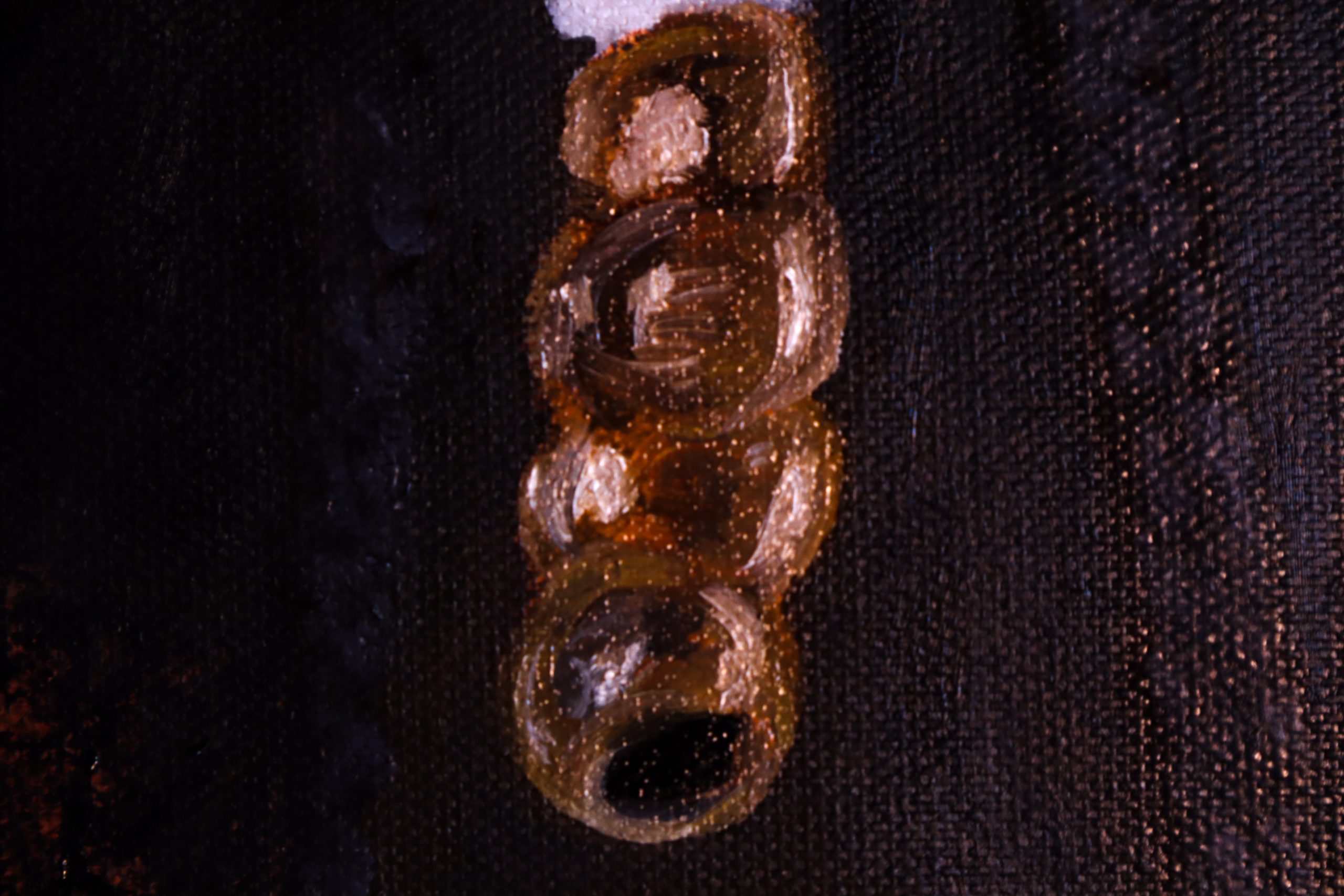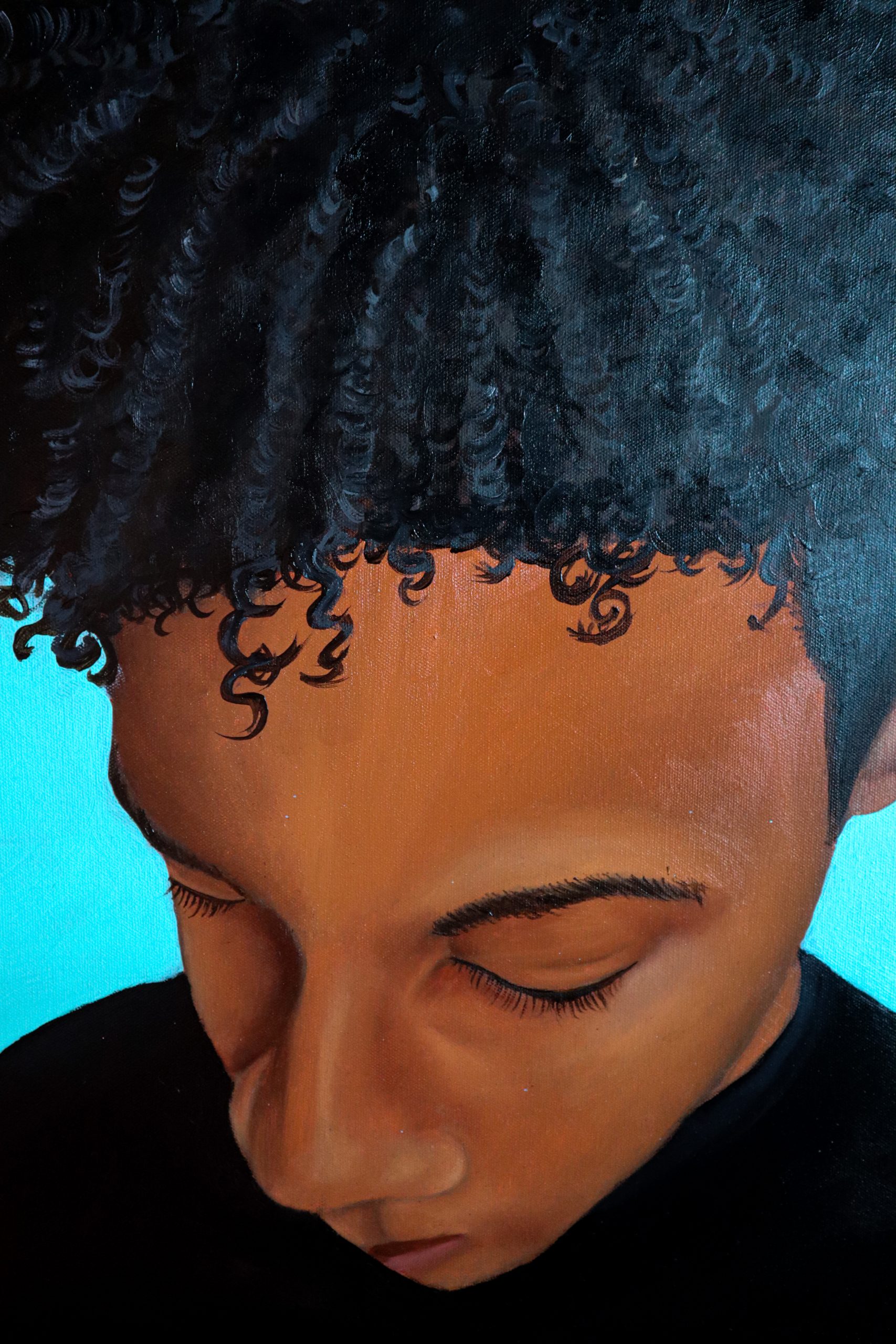Drawing 1, Sophomore Fall, 2018
I’ve always loved art, but it was always a personal hobby that I just taught myself. During my freshman fall, I enrolled in an entry-level Drawing 1 course. This was my first experience getting taught techniques and any professional help. I learned so much, but when it came to the self-portrait unit, I hit a brick wall. I found myself asking:
How do I draw curly hair without shading?
How do I capture dark skin with charcoal?
How do I create hair texture with a pencil?
I found myself hiding my natural hair to make assignments easier for myself, but, even then, I wasn’t proud of the work I was producing, and I still couldn’t capture my skin. For my first portrait in Drawing 1, we had to draw ourselves from life. I had a small mirror and a desk lamp as my light source. I recall putting on a wig for this assignment because I had previously struggled with capturing my kinky curls, and I watched our professor demonstrate straighter hair in class. While drawing myself, I was struggling with capturing the likeness of my skin. I had simplified the portrait to lights (highlights) and darks (shadows) as I was taught, but I couldn’t capture the reflectivity of light.

At the time, I wasn’t aware that darker skin absorbed more light. This was something my eyes could see, but I couldn’t translate into my drawing because it wasn’t something I was taught. Although there was some likeness, I saw that my complexion wasn’t a match at all. I remember crying out of frustration one night in my dorm room because it felt like no matter how hard I tried, I couldn’t capture myself, and I didn’t know-how. I put a wig on to avoid drawing my curls because it was a technique I was taught. I turned in the assignment not proud of my work, but I made sure that for the next assignment I would present my frustrations.
In the next assignment, we focused on an “alter ego” I wanted to embody my biggest fear at the time which was becoming another hashtag in the Black Lives Matter Movement. I wanted to depict a portrait of myself in photograph form. I wanted to capture my natural hair and darker skin. After class, I went to my professor with these questions and he simply directed me to other artists who have tackled these issues, but I wasn’t taught technique.
The image below is one example of a charcoal drawing I was directed to use for reference, by my professor.
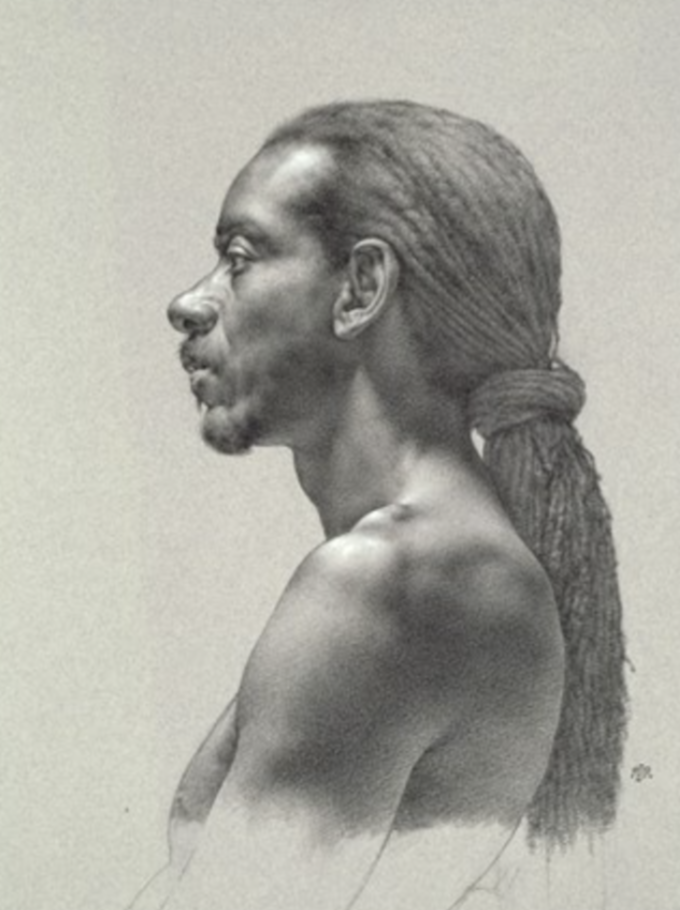
I didn’t process this at first, but as I reflected on this course, I realized that I had asked my instructor to demonstrate for me how to portray darker skin using charcoal, and instead of that how-to instruction, I received work already completed – not showing me the steps of how they got there, but that it was possible to get there.
After receiving a lack of instruction, I scheduled out more time to watch YouTube videos to teach me methods that would make this process easier. I found the YouTube video linked in the highlighted image, which helped me achieve the texture of the curls in the drawing below.
Instruction:
Click on the highlighted image and watch the quick 2-minute demonstration.
[drawattention ID=435]
Artwork by Destiny Kearney, 2018
The images below show a side-by-side comparison of my two self portraits, on the left before implementing my on pedagogical practice, and on the right after.
Artwork by Destiny Kearney, 2018
Painting 1, Junior Fall, 2019
I took Painting I during the fall of my junior year in 2019. In Painting 1, I spent most of the semester learning about the fundamentals of painting: its materiality and going through lessons on lights and darks using black and white, color matching, still life, a master copy painting, and finishing off with a self-designed project.
There was a notable encounter I had during class, after talking briefly with my professor about my research project. There was immediate interest in the subject matter, and they suggested I look into the work of Titus Kaphar. I was familiar with Kaphar’s work, and we spoke about our favorite pieces. The next time I had class, my professor pulled up this video of Titus Kaphar’s TED talk.
When the video played in class, I was observant of my peers. This wasn’t my first time watching it, but I wanted to see how they would react. Kaphar touched on the lack of representation he witnessed in his Intro to Art History course when a professor didn’t bother to speak on the contributions of Black artists because there “wasn’t enough time.” Kaphar’s work focuses on using art history to reconstruct the narrative of how we understand it, giving voices to narratives who were marginalized. My professor asked the class what they thought, and I remained silent because my research was driven in this work. I didn’t want to stand as a representative in that moment but be an observer. The room fell silent, and my professor decided to speak on Kaphar’s work for about a minute without any response to the video.
Nearing the end of the semester we engaged in the practice of “Master Copies”. The goal of completing a Master Copy Painting is to expose students to an artist and allow them to learn their style and techniques. I painted after Amy Sherald. I was interested in her work because of her muted skin tones in representations of Black people. This painting spoke to me because of the expression and detail in the hair. I struggled through this master copy, but I found myself learning a lot about how paint can depict texture in hair. I printed out details of the hair in the originals to learn how to mimic what Sherald did, and eventually, I learned my own technique through doing it repeatedly. This was an individual learning experience that pushed me to study how other Black artists, like Sherald, represented other Black people. I used the master copy assignment to answer these questions I had regarding how to depict Black people in the painting. I didn’t learn much about skin tone here because Sherald purposefully mutes the skin to not focus solely on the color of one’s skin, but their personhood and being.
Instruction:
Click on the images below to enlarge them
Instruction:
Click on the hair on the portrait below for more information
[drawattention ID=”438″]
For my final project, I decided that I wanted to try out a self-portrait again. I made the decision to go with black and white because it was the language I was beginning to understand in painting. I wanted to capture my likeness by focusing on light and shadow. I studied my features and used an image that illuminated my face well so I would be able to recognize all of the tonal shifts across my skin. I began to understand the way darker skin absorbed light in this image. This was the first self-portrait painting I’ve ever done, and the first piece I created at Bowdoin that I believe accurately depicted my likeness as a Black and Indigenous woman.

Black Lady Art Group “Advanced Collaborative Study”, Junior Spring, 2020
In the spring of 2020, Amie Sillah ’20, Amani Hite ’20, and I participated in an independent study under the Visual Arts Department titled, Black Lady Art Group. Sillah created this course because:
“In my four years of undergraduate studies at Bowdoin College, I never had an art class with another Black student. For most of my education, I was deprived of transformative experiences with my Black peers in an art space. Instead, I found myself laden with hypervisibility in an academic environment”.
-Amie Sillah ’20
As Black women who have taken courses in the Visual Arts Department, we experienced first-hand the educational gaps and disconnect between our identities and the curriculum. We collaboratively explored the marriage and tension of what it means to be in and of as Black Women and translate our insights into our art. This addressed the problem of the absence of black-conscious pedagogy from my formal art education.
In this piece, I wanted to create a self-portrait using a different form of representation. Taking a stylized approach and using oil paint and a pallet knife I wanted to depict my Blackness and indigeneity. Technique-wise, I wanted to play around with the ways I could manipulate the texture of the paint to depict hair texture. I used a mix of grey tones to depict depth in the curls and incorporate light and shadow within the texture.

The piece below was going to be a part of a larger series. In this self-portrait, I wanted to depict a self-portrait that showed me in my natural state. I wanted to expand on the vocabulary I developed from the self-portrait and master copy from Painting 1. I took details of my hair again and studied the pattern of each curl learning which strokes mimicked the way curls fell. After getting comfortable with this technique, I decided to mimic the strokes in the nature of curls, each taking its own individual path, one not identical to the next.
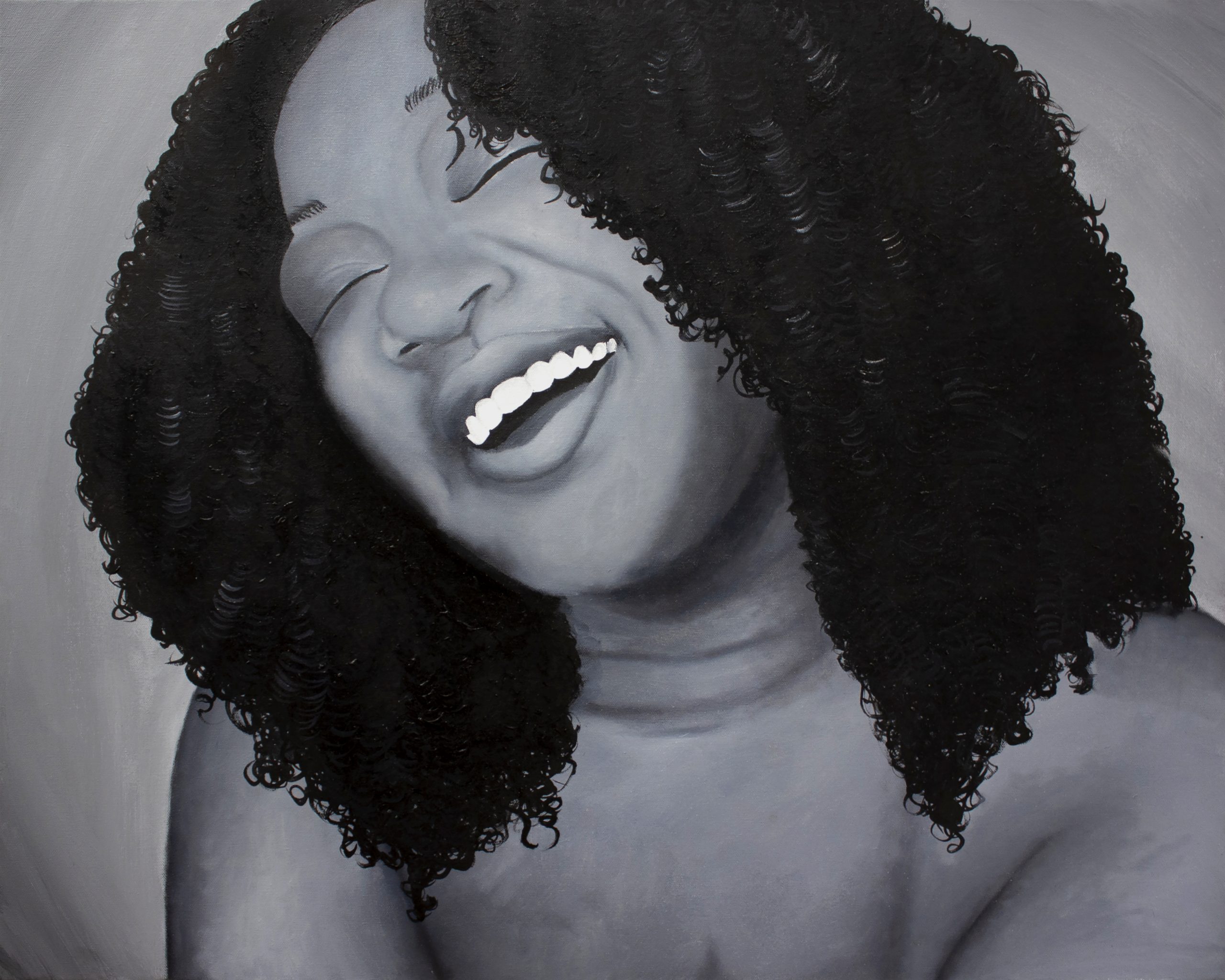
This course allowed me to gain a collaborative experience that I never received at Bowdoin, but most importantly it provided space for Black women to explore our identities in conjunction with ourselves, each other, and our environments. I was able to fill gaps in my education of Black artists and their contributions to the artistic canon. Additionally, we read works from bell hooks and discussed the fluidity of our intersectional identities in overly saturated white space like Bowdoin and, more specifically, Bowdoin’s Visual Arts Department.
Narrative Structures, Senior Fall 2020
During the Fall of 2020, I took Narrative Structures. Where I continued to build on my painting skill, with an emphasis on storytelling. Due to COVID-19, this class was also completely online, but I was able to grow independently.
In (my) recreation of Vermeer’s “Girl with a Pearl Earring,” I wanted to play around with the idea of representation. Thinking about Kehinde Wiley’s work, which solely portrays Black men, I wanted to picture myself taking the place of this girl Vermeer made everyone fall in love with and think about Art History and the absence of Black subjects taking up space in the narrative.
Instruction:
Click on the images below to enlarge them
Although it is a representational piece, I wanted to also place myself into the conversation of the greats and masters. Who are the masters of painting, and why don’t they include people who look like me? What if the “great artists” made portraits that centered on Black and brown bodies? What if the “great artists” were Black and Brown? How would that have changed the course of how we view Black people? This was my first painting done where I actually decided that I wanted to experiment and depict brown skin using paint. I still struggled with capturing the tonal changes across the skin, but while painting this, I went based on what I saw in the photograph. I just mimicked the colors that I saw reflected. Looking back, I can take note of the unnatural warmth to the skin that did not appear in the photo, but I assumed it would be there because I was brown.
For my final project, I wanted to focus solely on technique and I wanted the process of my art making to become a part of the work itself. In my Padlet that I displayed for the final, I included some videos of my process so that others would see how they went hand in hand. The Padlet was an overall map of my thoughts and how I taught through the development of this work.
This Padlet shows how I gathered material from other black artists, studying their work, methods, and techniques. I learned from examining their existing works and watching process videos. I also did my own research regarding the mixing of skin complexions in warm dark tones, warm light tones, black cool tones, and black cool dark tones. These taught me more about conceptualizing the colors that I was seeing and learning about the various undertones that can appear in darker-skinned people.
Instruction:
Please click the images below to enlarge
Instruction:
Please watch the video linked below that explains in detail my painting process of the portrait of my sister
[ensemblevideo version=”5.6.0″ content_type=”video” id=”2616e84c-e2cb-4460-8e98-abfadd89b5eb” width=”640″ height=”360″ displaytitle=”true” autoplay=”false” showcaptions=”false” hidecontrols=”true” displaysharing=”false” displaycaptionsearch=”true” displayattachments=”true” audiopreviewimage=”true” isaudio=”false” displaylinks=”true” displaymetadata=”false” displaydateproduced=”true” displayembedcode=”false” displaydownloadicon=”false” displayviewersreport=”false” embedasthumbnail=”false” displayaxdxs=”false” embedtype=”responsive” forceembedtype=”false” name=”Painting Process of Sisters Portrait”]
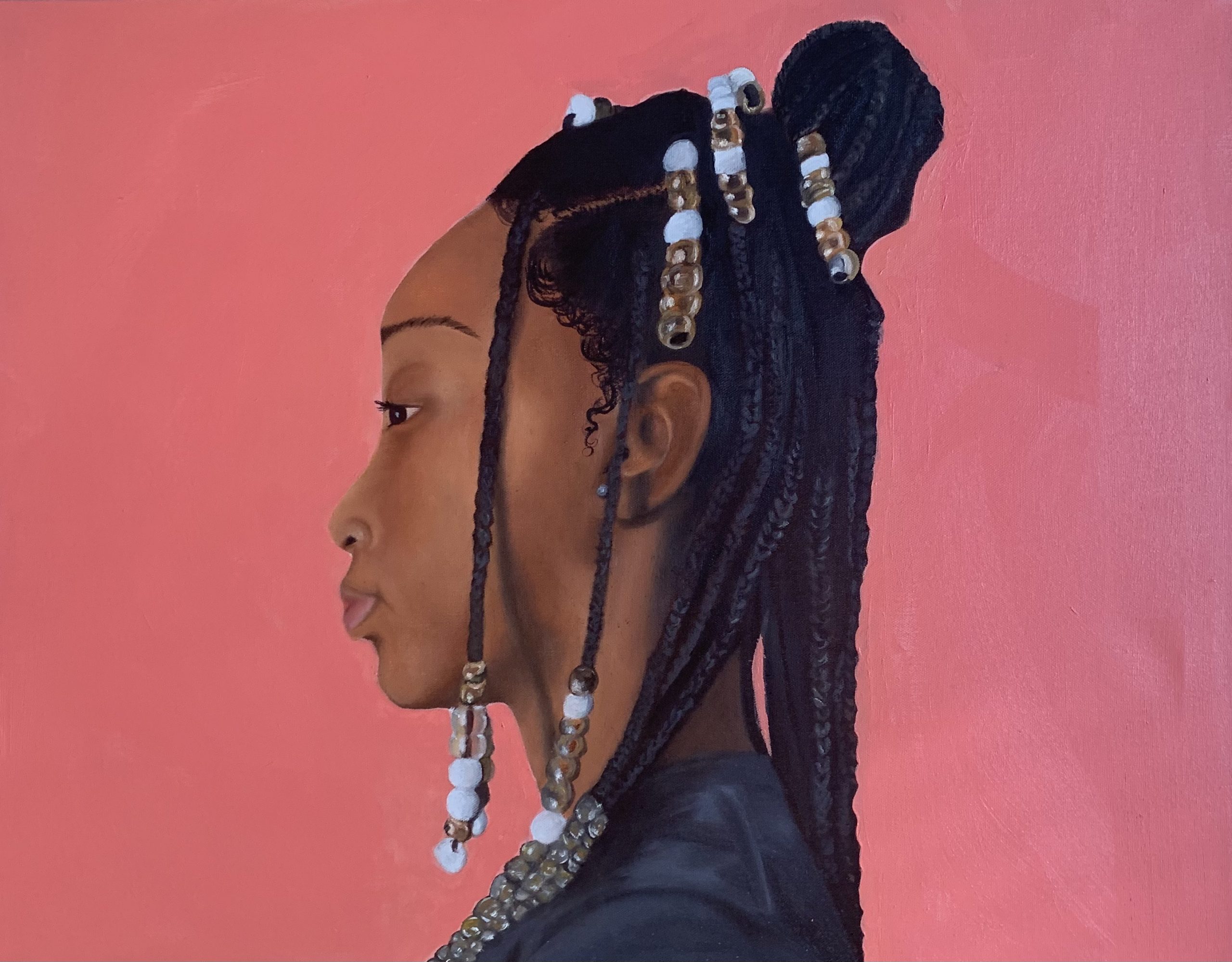
Instruction:
Please click the images below to enlarge
Artwork by Destiny Kearney, 2020
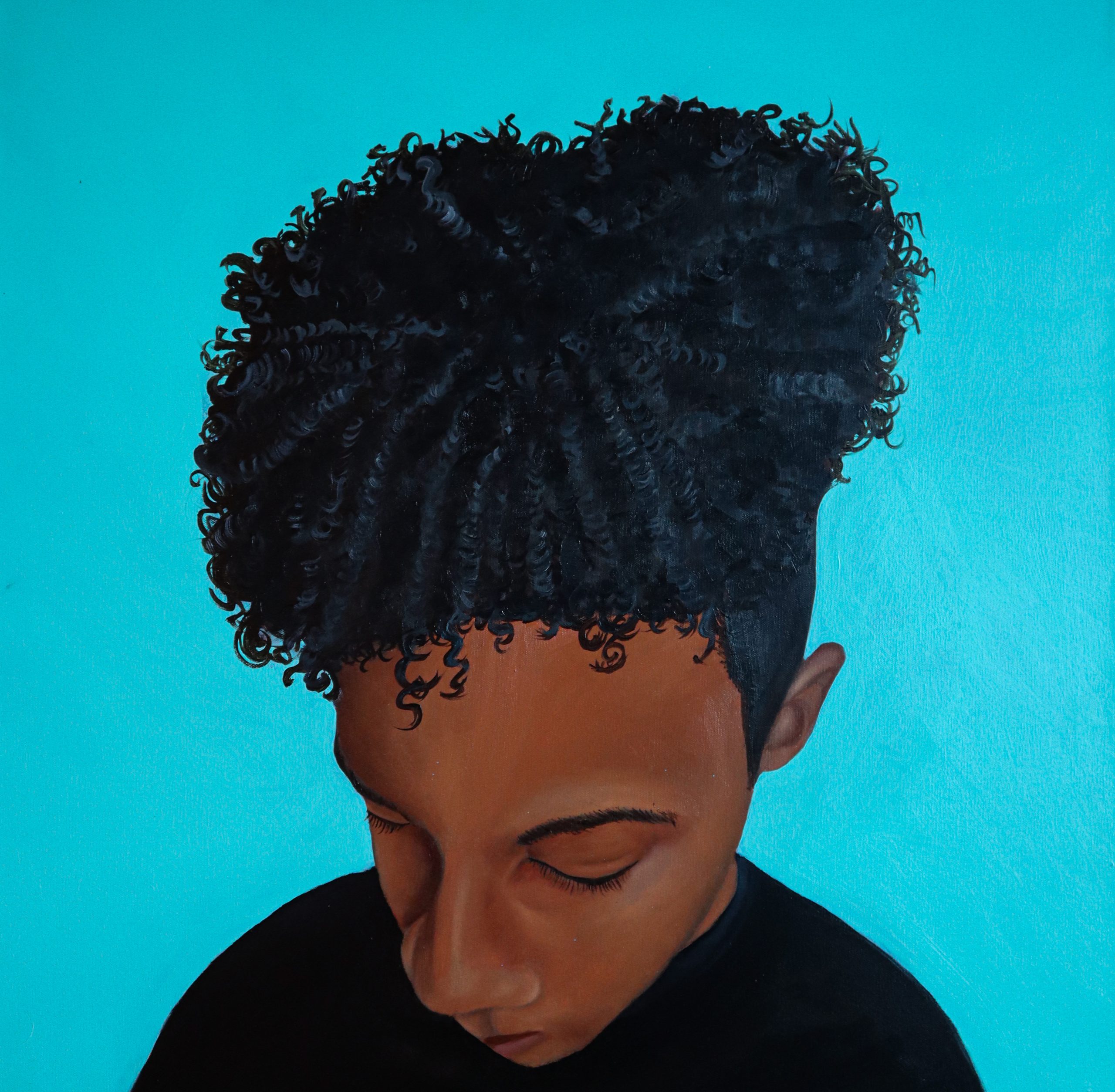
Instruction:
Click on the images below to enlarge them
Artwork by Destiny Kearney, 2020


